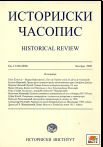Демографске прилике и мрежа парохија у Београдској епархији од 1718. до 1739. године
Demographic Situation and Parish Network in the Eparchy of Belgrade from 1718 to 1739
Author(s): Gordana Garić PetrovićSubject(s): History
Published by: Istorijski institut, Beograd
Keywords: Eparchy of Belgrade; demography; parishes; inhabitants; settlements; Habsburg Monarchy; Serbia
Summary/Abstract: During the Austro-Turkish wars dating from the end of 17th and the beginning of 18th century, significant demographic changes occurred on the area of the Eparchy of Belgrade. Numerous previous settlements disappeared, and number of the inhabitants considerably decreased, as a consequence of the population displacement. Areas of the Eparchy of Belgrade have not suffered from wars equally, nor have they recovered from them at the same pace. As we possess no detailed Austrian register of this ecclesiastical region, lists of settlements of ecclesiastical origin, including numerical state of the families, are proved to be of utter importance for the demographic study of this area. According to these, at least 3700 families, or slightly more than 15000 inhabitants dwelled in the Eparchy of Belgrade in the mid- 1720's. If we compare the given information with ecclesiastical registers dating from the mid- 1730's, we can clearly observe the increase in numerical state of the settlements, as well as in houses they counted. Migrations from the area under the Turkish rule have considerably contributed to demographic growth, but also has the return of some refugee families. According to the list of settlements and houses, composed approximately in 1735, 171 settlement, counting 4624 families, was registered in the Eparchy of Belgrade, or slightly more than 19000 inhabitants. Since an ecclesiastical register of the settlements and houses in the Bishopric of Valjevo, of the same year, has been preserved as well, we can conclude that more than 7000 families, or at least 29000 inhabitants dwelled in the Kingdom of Serbia, not counting Belgrade, by the end of the Austrian rule. The most prominent demographic growth, according to the information contained in ecclesiastical registers, has been recorded in regions under the administration of Timisoara, while it amounted to only approximately 5% in the surroundings of Belgrade. The biggest settlements were situated in the North, which reflected upon the population density that was multifold in the areas along Danube compared to the remaining parts of the eparchy. At the same time, a dense network of 64 settlements existed on the relatively small area of Stig and Braničevo. Hence, more than half of the population dwelled on the surface stretching from Belgrade to Golubac, of 2155 km2 (21,77% of the surface of the entire eparchy), with population density that amounted to 5,37 inhabitants per km2 in the mid- 1730's. Population density was many times smaller in other parts of the eparchy, and amounted to only 1,15 inhabitants per km2, while the average population density of the entire territory of the Eparchy of Belgrade was 2,08 inhabitants per km2.
Journal: Историјски часопис
- Issue Year: 2010
- Issue No: 59
- Page Range: 267-296
- Page Count: 30
- Language: Serbian

